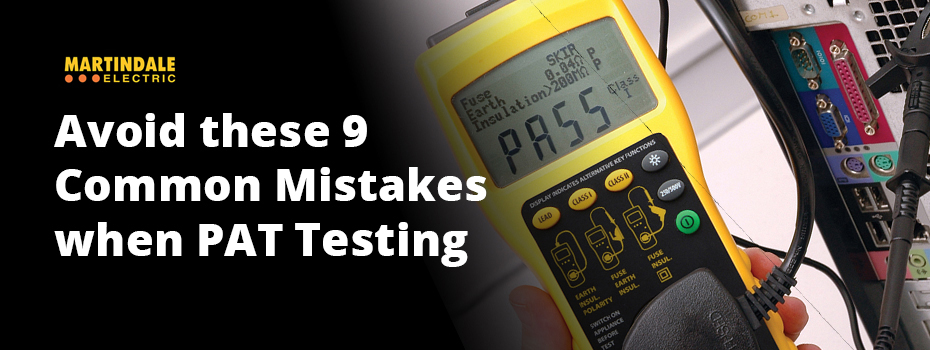
Even seasoned professionals with years of experience testing portable appliances are liable to make the occasional PAT testing mistake. Using Martindale’s guide to Basic PAT Testing Mistakes, we’ve compiled a list of nine common PAT testing mistakes to avoid.[1]
Quick Links
- Mistake 1: Incorrect Test Order
- Mistake 2: Forgetting to Switch the Appliance On
- Mistake 3: Not Checking that the Fuse is Conducting
- Mistake 4: Touching Appliances
- Mistake 5: Only Doing 1 Earth Bond Test
- Mistake 6: Taking the Incorrect Earth Reading
- Mistake 7: Only Doing 1 Insulation Test
- Mistake 8: Not Doing an Operation Test
- Mistake 9: Testing Earth Bond on Class II Appliances
- Further Information
Mistake 1: Incorrect Test Order
When checking Class I appliances, you must prove that the conductive earth path is good before running an insulation test. If you do not do this first, then you cannot rely on the insulation test result.
Mistake 2: Forgetting to Switch the Appliance On
In order to get a reliable insulation test result, you must switch on the appliance-under-test. Insulation tests work by detecting, via a probe or earth wire, whether voltage is escaping the appliance’s housing. During the test, everything in the appliance should be at 500V. However, if the appliance isn’t switched on then the voltage cannot pass through live wires. This could result in an incorrect pass of a dangerous appliance. For example, if a live wire within an appliance is broken and touching the outer casing you would not be able to detect voltage escaping through this wire without switching on the appliance.
Mistake 3: Not Checking that the Fuse is Conducting
Forgetting to switch the appliance on also means you will be unable to tell whether the fuse is functioning correctly. You do not need to perform a separate fuse test to check that it is conducting; an operation test will confirm that the appliance is both on and the fuse is working.
Mistake 4: Touching Appliances
Holding an appliance during insulation testing to improve probe contact is a bad habit to get into. This is because, whilst most appliances pass insulation tests, you will eventually encounter one that fails and, if you’re holding the appliance, you’ll receive a 500V shock.
Mistake 5: Only Doing 1 Earth Bond Test
Many early downloading PAT testers offered standard testing sequences with only one earth test. Due to this, even experienced professionals fall into the trap of only conducting one earth test. If an appliance has multiple, apparently isolated outer parts with separate earth paths, each one must be earth bond tested.
Mistake 6: Taking the Incorrect Earth Reading
If, as mentioned above, the appliance does have multiple, apparently isolated outer parts with separate earth paths and, therefore, requires multiple earth bond tests, don’t take the average reading. The only result that counts is the worst one.
Mistake 7: Only Doing 1 Insulation Test
As with earth bond testing, many early downloading PAT testers offered standard test sequences with only one insulation test and, for this reason, many professionals continue to perform this test just once. However, there are many areas on appliances where insulation may degrade; for instance, insulation may break down around the chuck, ventilation slots, trigger, assembly screws, and speed control of a power tool. To address this, Martindale recommends doing a second insulation test in which you wrap the appliance in kitchen foil and test the foil.
Mistake 8: Not Doing an Operation Test
Some entry-level PAT testers are unable to power up appliances/perform an operation test. In this situation, to make sure the appliance works correctly you should plug it into a socket (after PAT testing) and power it on.
Mistake 9: Testing Earth Bond on Class II Appliances
Martindale found that this was the most common problem reported to their technical helpline. Attempting to test the earth bond in a Class II appliance is guaranteed to result in failure because Class II appliances don’t have an earth.
Further Information
For more help and advice regarding PAT testing, our PAT courses, and/or our extensive range of PAT testers and PAT testing Kits, including models by Martindale, please contact our team on 01642 931 329 or via our online form.
To read Martindale’s guide to Basic PAT Testing Mistakes, please click here.
[1] Information for this blog was gathered using the following source:
- Martindale, Basic PAT Testing Mistakes: Things that frequently go wrong, last accessed 06 April 2022


